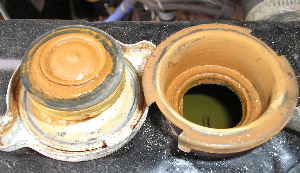Series cooling systems, and how i understand that they work -
Rad pressurises. At a set pressure, determined by the strength of the spring in the cap, the cap releases its rubber disc, and coolant escapes.
Here's a photo -

and another (ignore the chain) -

So, then the water is escaping...
It should then go down the tube to the expansion tank. See the tiny port on the right in this photo -

I know you can hardly see it - you can see the pipe comming off though.
That tube goes down to the base (not just the top) of the expansion tank.
Here's a photo -

So that's the heating cycle sorted.
Now when it cools....
See the center of the cap in the first photo? That's a valve - its sprung the other way. Here we go again -

So, the idea is that, when the system cools, that little central part springs the other way, and lets volume into the rad.
The IDEA is that the cap seals on that outer metal ring (?) and the fluid is then sucked back up from the expansion tank.
So....
If there was any air at all in the rad to start with, when it expanded, and the cap released, it should flow out, down to the base of the expansion tank, where, of course, it will bubble away. When the system cools, the fluid would be sucked back from the base of the expansion tank.
In this, the system would (sort of) be self bleeding. Assuming the expansion tank was topped up, the rad should never have any air in it at all.
Does yours? When you take of the cap on the rad (not the expansion tank) is it 100% full, no air at all?
See, what bothers me, is mine has air. I cant believe that the metal against metal seal on the outer rim of the cap ever works. Hence my question above as to if yours works.
Thank you for getting this far!
Rad pressurises. At a set pressure, determined by the strength of the spring in the cap, the cap releases its rubber disc, and coolant escapes.
Here's a photo -
and another (ignore the chain) -
So, then the water is escaping...
It should then go down the tube to the expansion tank. See the tiny port on the right in this photo -

I know you can hardly see it - you can see the pipe comming off though.
That tube goes down to the base (not just the top) of the expansion tank.
Here's a photo -

So that's the heating cycle sorted.
Now when it cools....
See the center of the cap in the first photo? That's a valve - its sprung the other way. Here we go again -
So, the idea is that, when the system cools, that little central part springs the other way, and lets volume into the rad.
The IDEA is that the cap seals on that outer metal ring (?) and the fluid is then sucked back up from the expansion tank.
So....
If there was any air at all in the rad to start with, when it expanded, and the cap released, it should flow out, down to the base of the expansion tank, where, of course, it will bubble away. When the system cools, the fluid would be sucked back from the base of the expansion tank.
In this, the system would (sort of) be self bleeding. Assuming the expansion tank was topped up, the rad should never have any air in it at all.
Does yours? When you take of the cap on the rad (not the expansion tank) is it 100% full, no air at all?
See, what bothers me, is mine has air. I cant believe that the metal against metal seal on the outer rim of the cap ever works. Hence my question above as to if yours works.
Thank you for getting this far!

